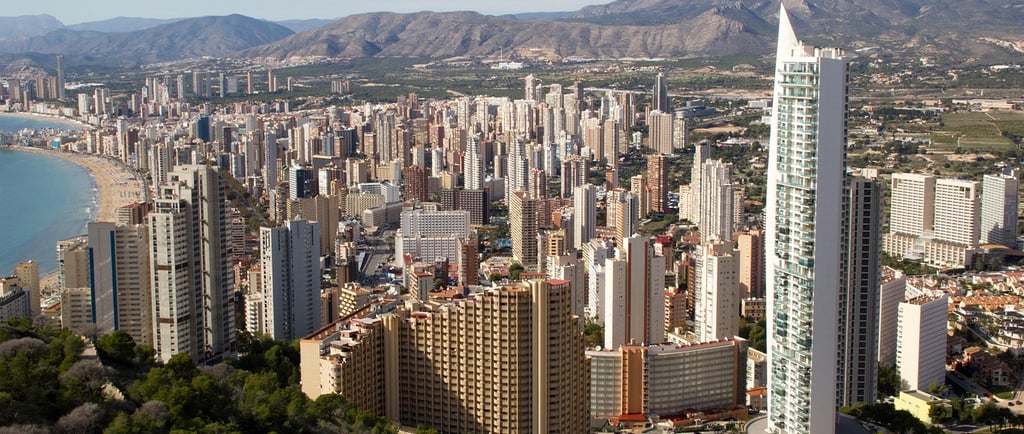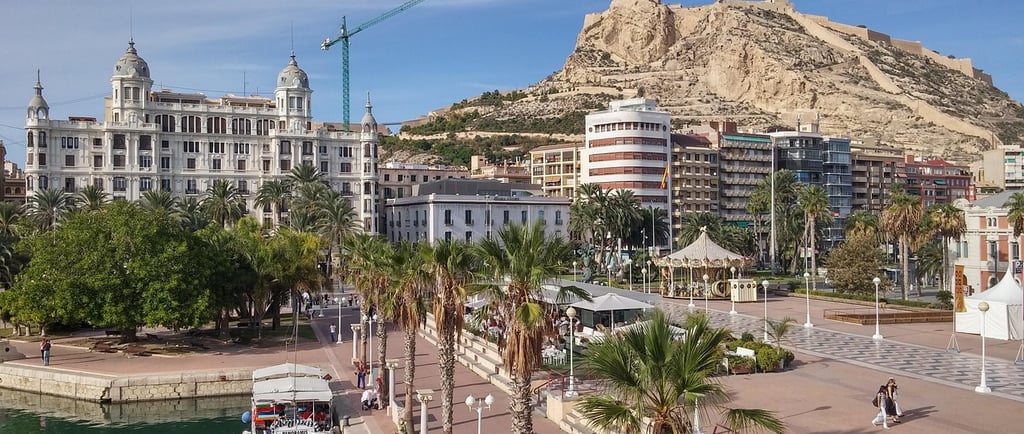I’m on vacation in Alicante, Spain, a sun-kissed escape.
This wears off quickly when I get off the plane and am enveloped by a warm breeze, thick like honey, mixed with the scent of salt and citrus at Alicante-Elche Airport. It was the beginning of June, the sun was high and the landscape appeared drenched in gold. After waiting many many months for this vacation, I was very excitedI slowly walked towards the taxi stand. Alicante, a coastal city on Spain’s Costa Blanca, promised a winning combination of history, culture, and relaxation. What I didn’t know was that my vacation in Alicante would go beyond my expectations.
3/26/20258 min read


Arrival and First Impressions
The drive I took from the airport into the city center was a visual banquet. The road snaked past palm-lined streets, whitewashed buildings and the sparkling Mediterranean Sea. My driver, a jovial local named Miguel, called out landmarks along the way, like the imposing Santa Bárbara Castle, which tops Mount Benacantil. “They are a castle, and you have to see it,” he said with a smile. “It is an amazing view from the top.”
Arriving in a chiefly Mediterranean island, I had booked a nice boutique hotel deep in the city, a quick stroll away from the Explanada de España, a famous promenade defined by palm trees and mosaic tiles. I had a tiny balcony overlooking a silent courtyard, with the sound of a trickling fountain as my background noise. After unpacking, I chose to walk around the city.
Walking the Explanada de España
The Explanada de España was even more magnificent in person than the pictures I’d seen. The wavy, red, cream and blue mosaic tiles glimmered in the sunlight, and the palm trees swayed gently in the breeze. Local and tourist alike were out walking along the preserve, some pausing to check out the street performers or shop at stalls selling handmade jewelry and souvenirs. I also couldn’t help picking up a pair of seashell earrings — a little souvenir from my first day in Alicante.
As I walked, I saw the slow pace of life. Amenable people were perched at outdoor cafés, it took a cup of coffee or a glass of wine, and kids played at the nearby Plaza de Luceros. The environment was vibrant, but not rushed, and I could feel myself starting to decompress.
Flavors of Alicante: Tapas and Seafood
By early evening my stomach was growling and I was ready to try local food. I had read that Alicante was a food lover’s paradise, and I was ready to eat as much as I could. I just went into a little cozy tapas bar, and that was just at the back of a small alley. The wall was decorated with colored tiles, the scent of garlic, olive oil, and fresh seafood filled the air.
I ordered a trio of tapas: patatas bravas, gambas al ajillo (garlic shrimp) and an indigenous specialty called arroz a banda, a rice dish cooked with fish broth. Every mouthful was mind blowing, filled with big flavors and fresh ingredients. A glass of local white wine recommended by the waiter, with which the meal went perfectly. As I enjoyed the final bite of my creamy flan, I decided I had found my new favorite cuisine.
Visiting the Santa Bárbara Castle
The following morning, I woke at dawn to avoid the heat and made my way to Santa Bárbara Castle. It was a steep, albeit slightly challenging walk up the mountain, however the views of the city and the sea were absolutely worth it. As I reached the top, I was met by the forbidding stone walls of this castle, which dated to the 9th century. I roamed through its hallways and climbed its tops for hours.
From the castle’s peak, I could see the whole city laid out around me—the busy port, the golden beaches and the kind of mountains that make my heart sing. It was an instant of unadulterated awe, and I felt so connected with the history and the beauty of Alicante.
A Day at Postiguet Beach
No visit to Alicante would be complete without a beach day so I made my way to Postiguet Beach, just a few steps from the city centre. Next up for me was a little lazing on the beach; the soft-gold sand and crystalline water were too hard to resist, so I settled down laying on my towel. There were people all over the beach, but it never felt overcrowded: families constructing sandcastles, couples wandering up and down the beach, packs of friends playing beach volleyball.
I woke up in Paz, and spent the day swimming in the warm Mediterranean waters. For lunch, I went to a local chiringuito (beach bar) and had fresh grilled sardines and horchata, a local beverage made from tiger nuts. Eating, I watched the waves roll in and experienced deep peace.
Finding the Old Town: Barrio de Santa Cruz
In the afternoon, I poked around Alicante’s Old Town, Barrio de Santa Cruz. This delightful neighborhood was a warren of narrow, serpentine streets with colorful houses decorated with flower pots and wrought-iron balconies. Turn a corner and find another surprise — a hidden plaza, a little chapel or a mural.
I came across the Basilica of Santa María, the oldest working church in Alicante, and went inside. The interior was beautiful, with ornate carvings, gold-leaf altars, and stained glass windows that projected a kaleidoscope of colors onto the stone floor. I lit a candle and reflected for a moment, very grateful for this amazing journey.
A Sunset to Remember
As night began to fall I headed back to the Explanada de España to watch the sunset. The sky glowed with shades of orange, pink, and purple and cast her light on the still waters of the harbor. I sat on a bench, listening to the soft strumming of a guitarist nearby and felt utterly at peace.
That evening, I indulged myself to a seafood dinner at a restaurant near the marina. I feasted on a platter of grilled octopus, prawns and mussels, with a bottle of crisp Albariño wine. As I ate each bite, I thought about the day’s activities and felt the sensation of fullness.
A Farewell to Alicante
The end of my final day in Alicante was bittersweet. I spent the morning hunting souvenirs — a jar of local honey, a bottle of olive oil and a handful of postcards to mail to friends back home. I further went to Central Market, where vendors sold all sorts of products including fresh vegetables, spices and cheeses. It was a sensory delight of vibrant colors and frenetic atmosphere.
I took one last stroll on the beach before going to the airport, dipping my feet in the waves. It was a time of reflection, a grateful recognition of all that had happened, the beauty I had been fortunate to encounter. Alicante had won my heart in ways I hadn’t realized, and I knew I’d always carry a piece of it with me.
As my plane took off, the coastline shrinking in the distance, I whispered a promise to myself to come back. It was a place, yes, but also the sense of the permanent escape to the foreign world of new experiences and new skills. Until next time, Alicante. Gracias por todo.


Things to know before visiting Alicante
Alicante, a vibrant coastal city on Spain’s southeastern Mediterranean coast, is a dream destination for travelers looking for sun, history, culture, and delicious cuisine. Known for its golden beaches, lively nightlife, and rich heritage, Alicante has something for every type of traveler. If you're planning a visit, here are some essential things you should know before going.
1. Getting to Alicante
Alicante is well-connected by air, train, and road. The Alicante-Elche Airport (ALC) serves as a major gateway, with direct flights from many European cities. If you're arriving from within Spain, the high-speed AVE train from Madrid can get you to Alicante in about 2.5 hours. Once in the city, public buses, trams, and taxis make getting around convenient, though the city center is very walkable.
2. Best Time to Visit
Alicante enjoys a Mediterranean climate with hot summers and mild winters. The best time to visit is from April to June and September to October, when the weather is warm but not too hot, and the crowds are smaller. July and August are peak tourist months, with temperatures often exceeding 30°C (86°F), while winter (November–March) is quieter but still pleasant for sightseeing.
3. Exploring the Old Town (El Barrio de Santa Cruz)
Alicante’s historic Old Town, known as El Barrio, is a charming neighborhood filled with colorful houses, narrow cobblestone streets, and lively squares. By day, you can explore its historical landmarks, including the Concatedral de San Nicolás, while at night, the area comes alive with bars and restaurants. It's the perfect place to experience Alicante's traditional and modern mix.
4. Castillo de Santa Bárbara – A Must-See Landmark
Overlooking the city from Mount Benacantil, the Santa Bárbara Castle is one of Alicante's top attractions. This medieval fortress offers panoramic views of the city and coastline, and you can reach it via a scenic hike, an elevator from Postiguet Beach, or by car. Visiting at sunset is highly recommended for breathtaking vistas.
5. The Beautiful Beaches
Alicante is famous for its stunning beaches, making it a great destination for relaxation. The most popular ones include:
Playa del Postiguet – Located near the city center, ideal for sunbathing and swimming.
San Juan Beach – A long stretch of golden sand with crystal-clear waters, perfect for families and water sports.
Playa de la Albufereta – A quieter, more local beach with a relaxed atmosphere.
If you’re looking for something more remote, take a short boat trip to Tabarca Island, a small paradise known for its pristine waters and excellent snorkeling spots.
6. Local Cuisine and Where to Eat
Alicante is a food lover’s paradise, especially for seafood and rice dishes. Some must-try local specialties include:
Arroz a banda – A delicious seafood rice dish cooked with fish broth.
Caldero – A hearty fish stew with rice.
Turrón – A traditional almond nougat, perfect for a sweet treat.
For an authentic experience, visit Mercado Central, the city's main market, where you can sample fresh seafood, cheeses, and local produce. Popular restaurants include La Taberna del Gourmet (for tapas), Nou Manolín (for fine dining), and El Portal (a trendy gastro bar).
7. Nightlife and Entertainment
Alicante has a lively nightlife scene, especially in El Barrio and the Marina area. From casual tapas bars to beachfront clubs, there’s something for everyone. Some top nightlife spots include:
Concerto Club – A great place for cocktails and live music.
Marmarela – A beach club with DJs and a rooftop terrace.
Isla Marina – Perfect for a relaxed evening with sea views.
If you prefer a quieter evening, consider attending a flamenco show at places like La Casa del Flamenco or enjoying an outdoor performance at the Teatro Principal de Alicante.
8. Shopping in Alicante
For shopping lovers, Alicante has a mix of local markets, boutique shops, and modern malls.
Explanada de España – A scenic promenade with artisan stalls selling souvenirs and handicrafts.
Mercado Central – Great for local food products, including fresh seafood, cheeses, and jamón.
El Corte Inglés – A large department store with fashion, electronics, and more.
For a unique experience, visit Alicante’s street markets, like the Plaza de Toros flea market on Sundays or the weekly markets in smaller neighborhoods.
9. Outdoor Activities and Day Trips
Alicante is not just about beaches and nightlife; it also offers excellent outdoor adventures.
Hiking – Try the Serra Grossa trail for stunning views of the city.
Watersports – Snorkeling, paddleboarding, and jet skiing are popular along the coast.
Cycling – Rent a bike and explore the coastline towards El Campello or Villajoyosa.
For a day trip, head to Guadalest, a picturesque mountain village with a castle and stunning lake views, or explore Altea, a charming whitewashed town just an hour’s drive away.
10. Cultural Events and Festivals
Alicante hosts several unique festivals throughout the year, making it even more special for visitors.
Las Hogueras de San Juan (June 20–24) – A spectacular fire festival with parades, bonfires, and fireworks.
Moros y Cristianos – A reenactment of the battles between Moors and Christians, held in different neighborhoods throughout the year.
Carnival (February/March) – A colorful event with street parties, costumes, and music.
If you’re visiting during one of these events, expect a festive atmosphere and plenty of cultural activities to enjoy.
11. Local Etiquette and Language Tips
Spanish is the official language, though many locals also speak Valencian. English is widely spoken in tourist areas, but learning a few basic Spanish phrases can be helpful and appreciated.
"Hola" (Hello) and "Gracias" (Thank you) go a long way.
When greeting, a handshake is common, but friends often greet with two kisses (one on each cheek).
Dining times in Spain are later than in other countries—lunch is usually between 1:30–3:30 PM, and dinner starts around 8:30–10:30 PM.
12. Packing Tips
In summer, bring light clothing, sunscreen, and sunglasses as it gets very hot.
Comfortable walking shoes are essential for exploring the Old Town and castle.
If visiting in winter, a light jacket is enough, as temperatures remain mild.
Final Thoughts
Alicante is a fantastic travel destination that combines history, culture, beaches, and delicious cuisine. Whether you’re exploring the lively streets of El Barrio, relaxing on a beach, or tasting local delicacies, this coastal gem offers an unforgettable experience. Plan your trip wisely, and you’ll discover why Alicante is one of Spain’s most beloved cities.
Contact us
Copyright © 2025. Ralnoscape All rights reserved.
Destinations
Resources


Follow us
This website uses affiliate links which may earn a commission at no additional cost to you
